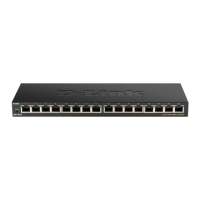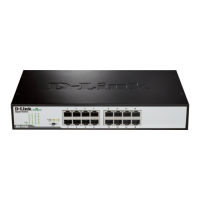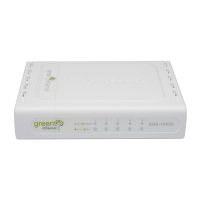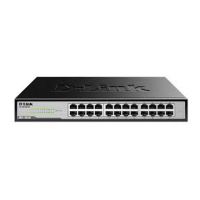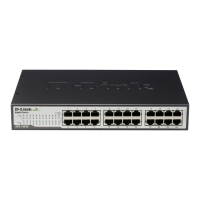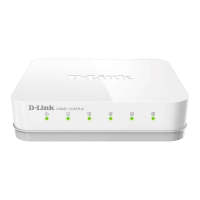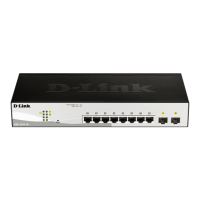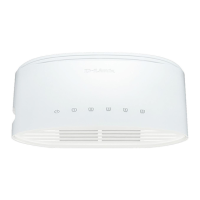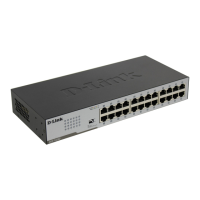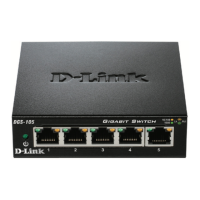Do you have a question about the D-Link DGS-1016A and is the answer not in the manual?
Details precautions to reduce risks of injury, shock, fire, and equipment damage.
Provides steps to prevent damage from static electricity to electronic components.
Introduces the manual and the switch's suitability for SOHO/small office users.
Describes the switch's ports and automatic features for speed and duplex negotiation.
Lists key features of the DGS-1016A/DGS-1024A switches, including performance and technology.
Explains the benefits and applications of Gigabit Ethernet technology.
Details energy-saving features like EEE and power saving by link status/cable length.
Identifies and describes the components visible on the front panel of the switch.
Explains the function of Power and Link/Act/Speed LED indicators.
Details the DC power connection and adapter specifications for the switch.
Describes the auto-negotiating Gigabit Ethernet ports and their LED indicators.
Lists the items included in the switch package for proper installation.
Provides guidelines for site preparation and optimal placement of the switch.
Explains how to mount the switch on a wall using provided hardware.
Describes the procedure for powering on the switch and what to expect from LED indicators.
Provides precautions to take during a power failure and upon power resumption.
Details how to connect individual devices like PCs to the switch using Ethernet cables.
Explains how to connect the switch to other network devices like hubs or other switches.
Describes how to connect the switch to network backbones or servers for network access.
Provides general technical details including standards, protocol, data transfer rates, topology, and network cables.
Lists physical dimensions, weight, power consumption, and environmental operating conditions.
Details performance metrics like transmission method, RAM buffer, MAC address table, and forwarding rate.
Details precautions to reduce risks of injury, shock, fire, and equipment damage.
Provides steps to prevent damage from static electricity to electronic components.
Introduces the manual and the switch's suitability for SOHO/small office users.
Describes the switch's ports and automatic features for speed and duplex negotiation.
Lists key features of the DGS-1016A/DGS-1024A switches, including performance and technology.
Explains the benefits and applications of Gigabit Ethernet technology.
Details energy-saving features like EEE and power saving by link status/cable length.
Identifies and describes the components visible on the front panel of the switch.
Explains the function of Power and Link/Act/Speed LED indicators.
Details the DC power connection and adapter specifications for the switch.
Describes the auto-negotiating Gigabit Ethernet ports and their LED indicators.
Lists the items included in the switch package for proper installation.
Provides guidelines for site preparation and optimal placement of the switch.
Explains how to mount the switch on a wall using provided hardware.
Describes the procedure for powering on the switch and what to expect from LED indicators.
Provides precautions to take during a power failure and upon power resumption.
Details how to connect individual devices like PCs to the switch using Ethernet cables.
Explains how to connect the switch to other network devices like hubs or other switches.
Describes how to connect the switch to network backbones or servers for network access.
Provides general technical details including standards, protocol, data transfer rates, topology, and network cables.
Lists physical dimensions, weight, power consumption, and environmental operating conditions.
Details performance metrics like transmission method, RAM buffer, MAC address table, and forwarding rate.
| Switching Capacity | 32 Gbps |
|---|---|
| Forwarding Rate | 23.8 Mpps |
| MAC Address Table Size | 8K |
| Packet Buffer Memory | 512 KB |
| Jumbo Frame Support | 9KB |
| Operating Temperature | 0 to 40 °C (32 to 104 °F) |
| Storage Temperature | -40 to 70 °C |
| Humidity | 10% to 90% (non-condensing) |
| Ports | 16 x 10/100/1000 Mbps |
